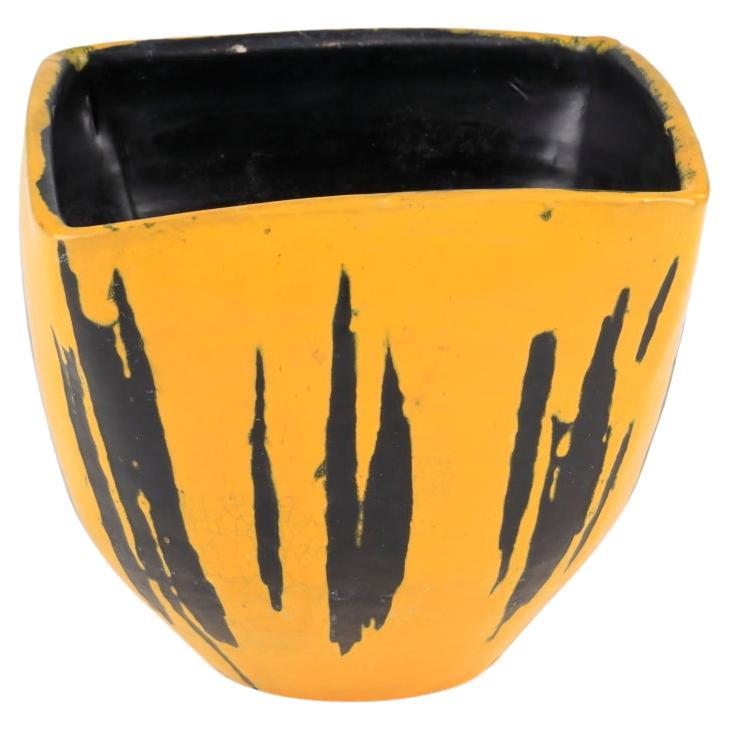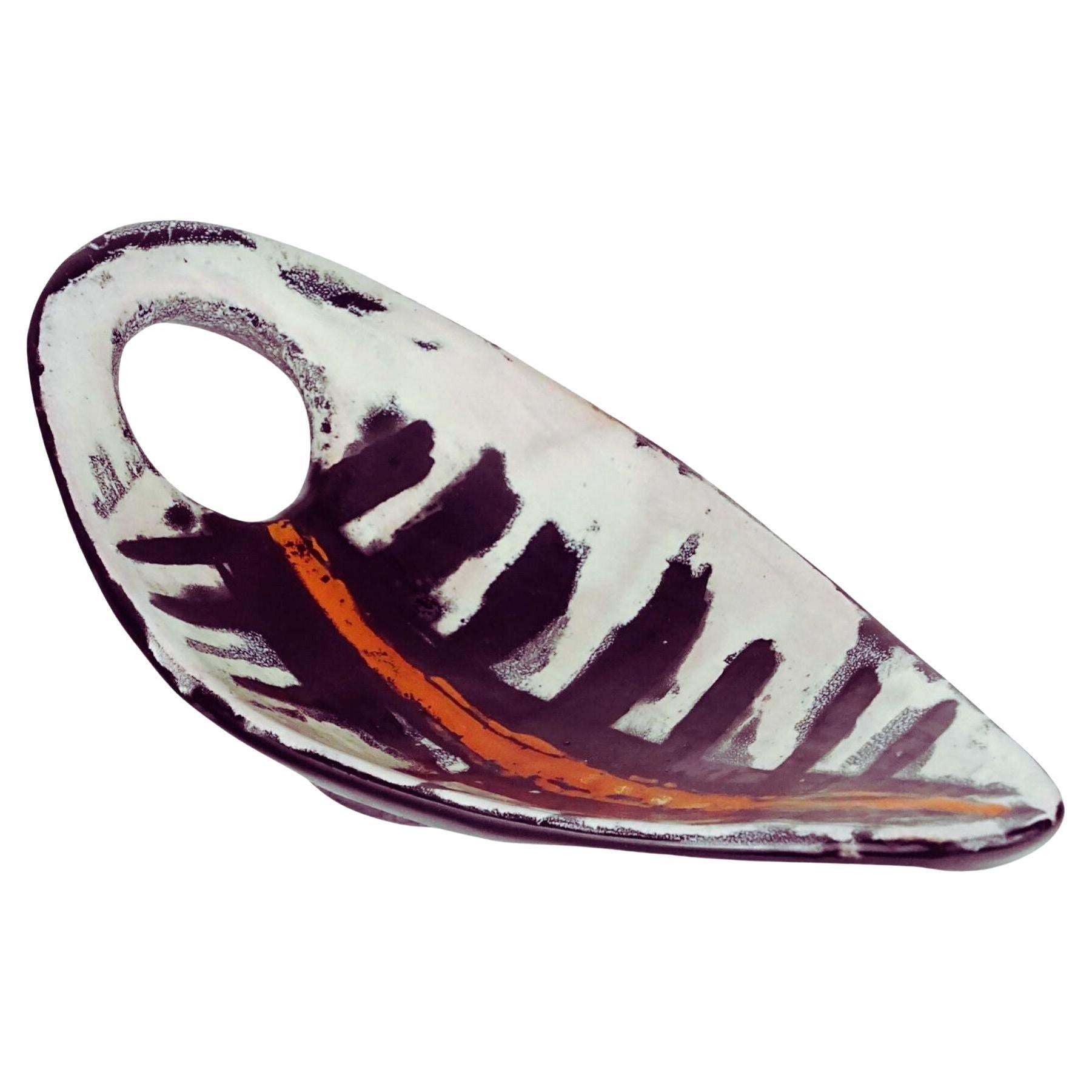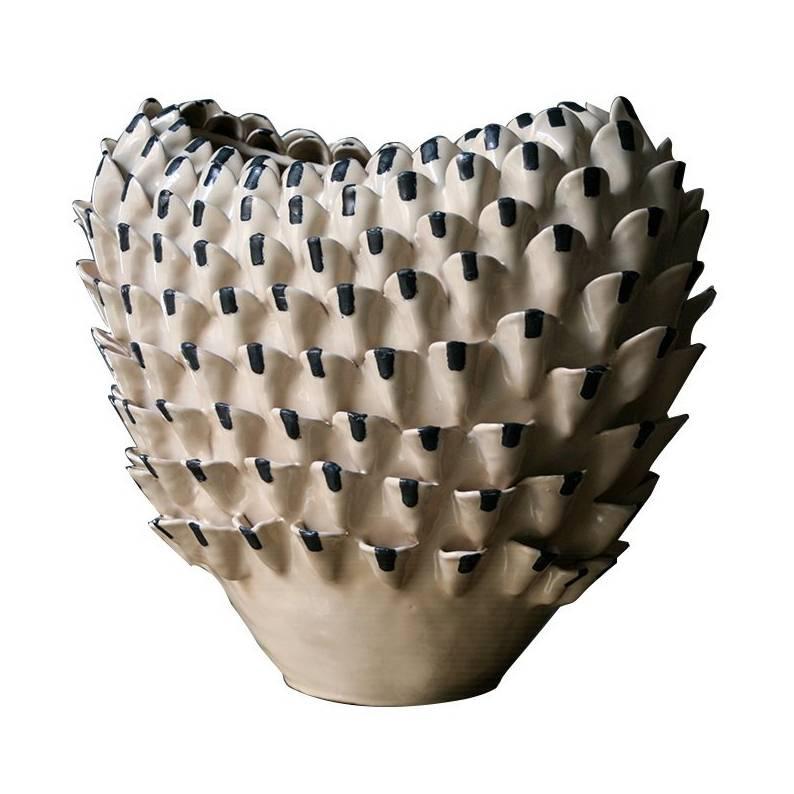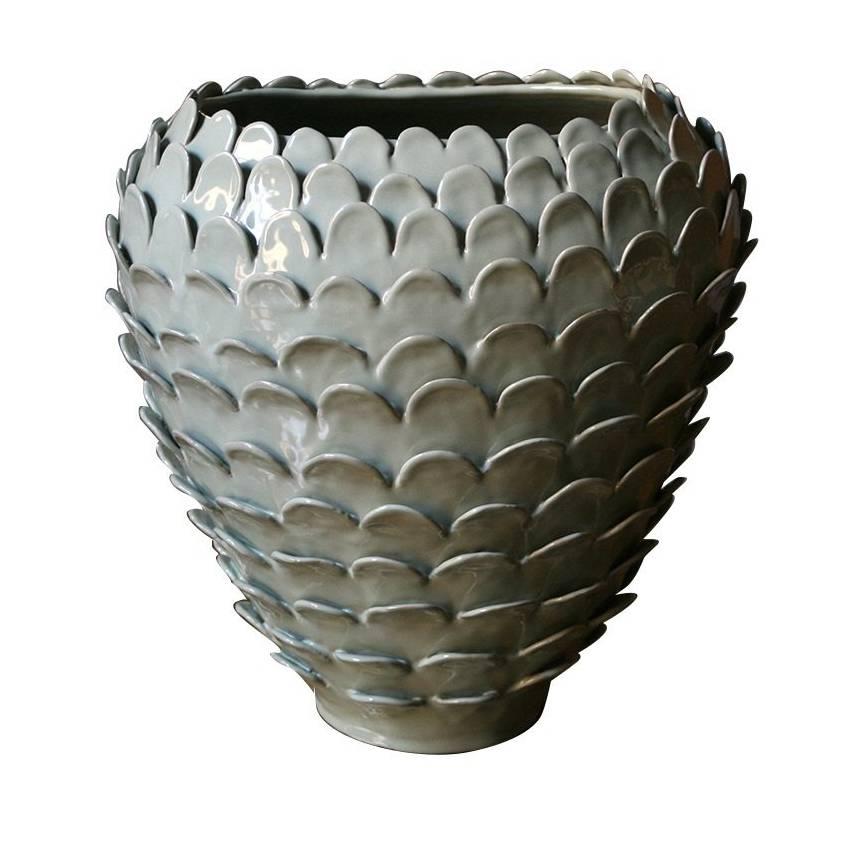Want more images or videos?
Request additional images or videos from the seller
Livia Gorka Vase
About the Item
The ceramic work of Livia Gorka stands out as truly unique and special, bearing the hallmark of her masterful craftsmanship, deep connection to nature, and innovative approach to pottery.
At the heart of her distinctive style lies Gorka's reverence for the natural world, which serves as a constant source of inspiration for her art. Drawing upon elements from nature, such as stones, fish, birds, and asymmetrical vessels, Gorka infuses her ceramics with a sense of organic vitality and dynamism that sets them apart from more conventional forms.
This ceramic vase, with its very dark background color contrasted with vibrant shades of orange and white, exemplifies Gorka's penchant for creating visually striking compositions that captivate the viewer's attention. Through her careful manipulation of color and form, she transforms ordinary vessels into extraordinary works of art, each bearing a unique and compelling narrative.
Gorka's mastery of the prewheel archaic technique of working in clay further distinguishes her ceramics as objects of exceptional craftsmanship and artistry. By eschewing conventional methods in favor of more ancient practices, she imbues her creations with a sense of timelessness and authenticity that resonates deeply with viewers.
Moreover, Gorka's preference for producing her ceramics in series and groups of objects speaks to her desire to explore themes and motifs in depth, allowing for a rich and multifaceted exploration of her artistic vision. While each piece may be unique in its own right, they collectively form a cohesive body of work that reflects Gorka's commitment to artistic exploration and innovation.
In terms of technique, Gorka frequently opts for high-fired stoneware, utilizing her own clay bodies to achieve desired textures and finishes. She often employs oxide glazes to enhance the visual impact of her pieces, creating a subdued color palette that lends her work a sense of understated elegance and sophistication.
Furthermore, Gorka's willingness to experiment with unconventional materials, such as metals, adds an additional layer of complexity and depth to her ceramics, further expanding the boundaries of traditional pottery and pushing the limits of artistic expression.
In summary, the ceramic work of Livia Gorka stands as a testament to her unwavering dedication to craftsmanship, innovation, and artistic exploration. Through her unique blend of ancient techniques, nature-inspired motifs, and innovative use of materials, she creates ceramics that are not only visually stunning but also deeply resonant, inviting viewers to contemplate the beauty and complexity of the natural world.
- Creator:Livia Gorka (Artist)
- Dimensions:Height: 12.6 in (32 cm)Diameter: 4.73 in (12 cm)
- Materials and Techniques:
- Place of Origin:
- Period:
- Date of Manufacture:Circa 1950
- Condition:Minor fading.
- Seller Location:New York, NY
- Reference Number:1stDibs: LU9498239146332
About the Seller
New to 1stDibs
Joined in the past six months.
No Reviews Yet
Vetted Seller
These experienced sellers undergo a comprehensive evaluation by our team of in-house experts.
1stDibs seller since 2023
Typical response time: 19 hours
- ShippingRetrieving quote...Ships From: New York, NY
- Return PolicyA return for this item may be initiated within 7 days of delivery.
More From This SellerView All
- 1950's Livia Gorka Ceramic BowlBy Livia GorkaLocated in New York, NYThis Livia Gorka ceramic bowl stands out as a truly exceptional piece, embodying the artist's unique vision and expertise. The striking combination of black and yellow hues, accente...Category
Vintage 1950s Hungarian Ceramics
MaterialsCeramic
- Elizabeth Garouste & Mattia Bonetti SofaLocated in New York, NYElizabeth Garouste (French, born 1949), a former costume designer, and Mattia Bonetti (Swiss, born 1952), a photographer, together used to form a Paris-based design team specializing...Category
20th Century French Sofas
MaterialsBronze
- Joaquim Tenreiro Curva SofaBy Joaquim TenreiroLocated in New York, NYJoaquim Tenreiro was among the leading furniture designers and visual artists in mid-20th century Brazil. Tenreiro was born in Portugal into a family of woodworkers and carpenters. In the late 1920s, he emigrated to Rio de Janeiro and began working for the firm of Laubisch Hirth...Category
Mid-20th Century Sofas
MaterialsFabric, Jacaranda
- Joaquim Tenreiro Curva ArmchairsBy Joaquim TenreiroLocated in New York, NYJoaquim Tenreiro was among the leading furniture designers and visual artists in mid-20th century Brazil. Tenreiro was born in Portugal into a family of woodworkers and carpenters. In the late 1920s, he emigrated to Rio de Janeiro and began working for the firm of Laubisch Hirth...Category
Mid-20th Century Armchairs
MaterialsFabric, Jacaranda
- Carlo Hauner Long ChairLocated in New York, NYCarlo Hauner (1927 — 1997) & Martin Eisler (1913 — 1977) Hauner & Eisler were the primary designers for the iconic Brazilian furniture company Forma – their work counts as one of th...Category
Vintage 1950s Brazilian Chaise Longues
MaterialsFabric, Jacaranda
- Martin Eisler Attribution Canr Brazilian ArmchairBy Martin EislerLocated in New York, NYCarlo Hauner (1927 — 1997) & Martin Eisler (1913 — 1977) Hauner & Eisler were the primary designers for the iconic Brazilian furniture company Forma – their work counts as one of th...Category
Vintage 1950s Brazilian Armchairs
MaterialsMetal
You May Also Like
- Lívia Gorka Decorative Ceramic Bowl, Hungary ca 1960sBy Livia GorkaLocated in Budapest, HUMunkácsy Mihály Prize-winning Hungarian ceramicist, worthy artist, and daughter of Géza Gorka, Gorka Lívia is one of the most renowned Hungarian ceramists. Her present work is a highly distinctive piece even if measured against her own exceptional repertoire. In 1947, Lívia Gorka passed her master's exam in pottery. Her master was his father, Géza Gorka. As an independent, self-employed artist, se worked in the Gorka workshop in Verőce until 1959, and had created in her own studio after that. The source of her art has always been nature, and as such, her typical objects (if we can discuss typical at all in her case) are large, asymmetrical vessels, idols, fish, birds, and stones. Gorka preferred creating unique objects and to think in series and groups of objects. She worked with high-fired, custom-made materials such as stone, oxide clay glazes, and often combined clay with metal. The colours of her works have a strong plastic effect and are generally quite restrained. This handmade piece reflects her minimalistic and timeless language of forms that appears in every inch of this bowl that is in the field between art, design, and handicraft. The colours are spectacular, the black glazed outside harbours a medley of shapes and colours on the inside. This glazed, geometrically decorated piece has an unusual, modern shape with a hollow opening on top. The bright orange line traces the shape to the hollow opening towards the top and articulates the unusual angle at which the bowl stands. Lívia Gorka was able to step out of her father's shadow and create her own style with her ceramics. A true artist who always worked with craft techniques, she also developed her own technique for making the glaze, so her works, like this bowl, always represent a recognizable, unique world of shapes and colours. Gorka was a master of these subtleties that established her one-of-a-kind visual language that is still coveted not just in her native Hungary, but all around the world among ceramic enthusiasts and collectors. Thanks to this, it can easily be placed in both a vintage or contemporary interior and is sure to stand out from its surroundings. About the designer: Gorka Lívia (Nógrádverőce March 5, 1925 – Diszel, August 4, 2011) Mihály Munkácsy Prize-winning Hungarian ceramicist, a distinguished artist. Daughter of Géza Gorka. She was born in Nógrádverőce to Géza Gorka and Irén Kovács. She received her professional and artistic training in her father's workshop. She got used to serious work when he was six or eight years old, as she worked in his father's workshop during school breaks...Category
Vintage 1960s Hungarian Mid-Century Modern Ceramics
MaterialsCeramic
- Zaccagnini VaseBy Ugo ZaccagniniLocated in New York, NYLarge-scale ceramic vase by Zaccagnini. Hand-thrown earthenware vase. Brown and white glazes with incised leaf pattern and interior glaze. Beautiful graphic piece with great scale. ...Category
Vintage 1950s Italian Vases
- Artemisia N.2 VaseBy Claudia FrignaniLocated in Milan, ITThe bright turquoise glaze of this striking terracotta vase brings the large, raised fish scale pattern into focus. Part of the Artemisia collection, this piece is entirely handmade ...Category
2010s Italian Vases
MaterialsCeramic
- Artemisia N.4 VaseBy Claudia FrignaniLocated in Milan, ITCovered with a pattern made of dense, decorative, raised scales, this unique vase in white glazed terracotta combines a bold pattern with an elegant finish. The scales have a small, ...Category
2010s Italian Vases
MaterialsCeramic
- Artemisia N.5 VaseBy Claudia FrignaniLocated in Milan, ITElegant yet simple, this terracotta vase reveals its origin in the rustic hand-carved design, which was obtained using the colombino technique, an ancient coiling method used to prod...Category
2010s Italian Vases
MaterialsCeramic
- Lefka N.8 VaseBy Claudia FrignaniLocated in Milan, ITMade using the colombino method and glazed using a two-step firing process to add a striking glossy white finish, this vase is a true work of the highest craftsmanship. The decoratio...Category
2010s Italian Vases
MaterialsCeramic





